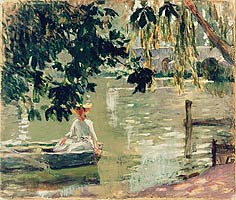When you look
at the ‘River Scene’ - do you see that part of the bank has
been painted over? It turns out, looking closer,
that the whole painting has been changed in a very exciting way!
Read more about this later on!
Dominating in
the foreground are the branches with leaves hanging down like a
curtain, ‘like a fringe of foliage’. This way of using a foliage,
trunks, etc., as a 'stop'
for our eyes, gliding further into the scene, is very often used by
Monet.
Picture yourself
standing next to the
artist on the riverbank, in the shadowy light, looking out over the
water. You can almost feel a light breeze coming from the river. It
is noon and it is a hot day!

Before we continue, let
us listen to Claude
Monet himself, when he describes how to paint:
“When you go out to
paint, try to forget what objects you have in front of you, a tree,
a field. Merely think, here is a little square of blue, here is an
oblong of pink, here a streak of yellow, and paint is just as it
looks to you, the exact colour and shape until it gives you your own
naive impression of the scene.”
(From ‘River of Light’, by
Douglas Skeggs, London 1987).

Claude Monet Painting at the Edge of a Wood
(detail),
by John Singer Sargent, Tate Gallery London.
Douglas Skeggs writes:
“The technique as described by Monet sounds simple enough, but it
requires painstaking concentration, as each tone and colour must be
exactly right before it reaches the canvas. The effect, however,
cannot be matched; it is fresh and spontaneous and gives the
illusion of having been effortlessly achieved.”
Click
HERE for next page